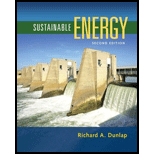
Sustainable Energy
2nd Edition
ISBN: 9781337551663
Author: DUNLAP, Richard A.
Publisher: Cengage,
expand_more
expand_more
format_list_bulleted
Concept explainers
Expert Solution & Answer
Want to see the full answer?
Check out a sample textbook solution
Students have asked these similar questions
The levelized cost of energy (LCOE) for coal-fired electricity is about $0.09/kWh. Suppose the capital cost of the plant is $600 million and it operates for 40 years with a capacity factor of 95%. What is the contribution of CAPEX to LCOE? Given the difference you (hopefully) find, what contributes the remaining costs?
The demand for electric power is usually much higher during the day than it is at night, and utility companies often sell power at night at much lower prices to encourage consumers to use the available power generation capacity and to avoid building new expensive power plants that will be used only a short time during peak periods. Utilities are also willing to purchase power produced during the day from private parties at a high price.
Suppose a utility company is selling electric power for $0.06/kWh at night and is willing to pay $0.13/kWh for power produced during the day. To take advantage of this opportunity, an entrepreneur is considering building a large reservoir 50 m above the lake level, pumping water from the lake to the reservoir at night using cheap power, and letting the water flow from the reservoir back to the lake during the day, producing power as the pump–motor operates as a turbine–generator during reverse flow. Preliminary analysis shows that a water flow rate of 2…
2. Consider the system described in the news: at night, when there is energy left, water is pumped from a large lake to a reservoir at 80 m above the lake level. During the day, this water is used to generate energy in a turbine located 80 m below the elevated reservoir. Considering that the water flow is always 5000 liters/s (both at the inlet of the reservoir and at the outlet) and that the pump and turbine efficiencies are 70%, what is the power (in kW) required by the pump and the power (in kW) recovered in the turbine. Data: The pipe diameter is always the same along the system (d = 0.5 m); g = 10 m/s2; γ = 9810 N/m3.
Matter transport phenomena;
Please make it typeable as handwriting interferes with understanding
Knowledge Booster
Learn more about
Need a deep-dive on the concept behind this application? Look no further. Learn more about this topic, civil-engineering and related others by exploring similar questions and additional content below.Similar questions
- In the figure shown below, it is desired to pump 5259705 lit/day of water from a stream to a pool. El. A = 49m while El. B = 98 m. If the combined pump and motor efficiency is 90%, calculate the monthly power cost in pesos if electricity rate is P10 per kW-hr. Assume that the pump operates for 24 hours and take 1 month = 31 days; Round your answer to 4 decimal places. Pipe Length (m) Diameter (mm) Hazen Coefficient 1 1997 m 375 mm 120 2 1514 m 240 mm 122 3 902 m 205 mm 149arrow_forwardWhich of the following statements is incorrect? An energy budget can be based on historical data, although this is usually unsatisfactory There is no standard formula for to calculate electricity costs The electricity consumption of air-conditioning can comprise of 80%-90% of the load of a building Economic cycle operation refers to the use of favourable environmental conditionsarrow_forwardA town uses water from a reservoir that holds 200 million L and is replenished at a rate of 60 million L a day. In 2020, the town used 46 million L per day, calculate the average water use per person per day. (Town population: 70,230)arrow_forward
- If the rotational speed of a pump motor is reduced by 35%, what is the effect on the pump performance in terms of capacity, head, and power requirements?arrow_forwardThe Stortemelk hydropower project consists of a single 4.4 MW vertical Kaplan turbine installed at the Botterkloof Dam on the Ash River near Clarens, in the Free State Province of South Africa.Construction commenced in September 2014, completed on time and commissioned in June 2016 using more than 150 different companies at a cost of R2.5 billion. Day to day operations is repetitive ongoing work. Projects are different from operations, state any five project attributes.arrow_forward8.If the pump removes 1.65 gal/min of water from a tank, how long will it take to empty the tank if it contains 7,425 lb of water?arrow_forward
- Assuming a factor of safety of 2, what will be the water demand when water consumption per capita is 3.7 litres/day in a community of 6000 people and the minimum water released from a reservoir is 150,000 litres?arrow_forwardA device that monitors rotational vibration changes in turbines may be purchased for use in southern California wind farms. The first cost is $40,000 with a constant AOC of $15,000 over a maximum service period of 6 years. Use the decreasing future market values and i = 20% per year to find the best n value for an economic evaluation.arrow_forwardB- Discuss the following claimed arguments: [6] 1- Shallow ground geothermal systems can play an essential role in the future of renewables in Palestine. 2- Two way communication systems are essential in smart grid technology. 3- Type 4 of wind turbine technologies has many advantages in comparison with other technologies.arrow_forward
- A drum contains a roll of copper wire 15 mm in diameter and 1 KM long. Calculate 1- the volume of wire in cubic m (m3) on the drum. 2- the cost of the drum of wire if copper costs $ 23,941 per cubic m (m3).arrow_forwardAssume that a residential area has a water pipe leaking continuously at the rate of 1.5 litres/sec. Calculate the total volume of water in million cubic metres that will be lost through leakage during the month of December.arrow_forwardwe will cover engineering economics. For now, using the Excel Helpmenu, familiarize yourself with the following functions. Create a simpleexample and demonstrate the proper use of the function.a. FV(rate, nper, pmt, pv, type)b. IPMT(rate, per, nper, pv, fv, type)c. NPER(rate, pmt, pv, fv, type)d. PV(rate, nper, pmt, fv, type)arrow_forward
arrow_back_ios
SEE MORE QUESTIONS
arrow_forward_ios
Recommended textbooks for you

 Sustainable EnergyCivil EngineeringISBN:9781133108689Author:Richard A. DunlapPublisher:Cengage Learning
Sustainable EnergyCivil EngineeringISBN:9781133108689Author:Richard A. DunlapPublisher:Cengage Learning


Sustainable Energy
Civil Engineering
ISBN:9781133108689
Author:Richard A. Dunlap
Publisher:Cengage Learning